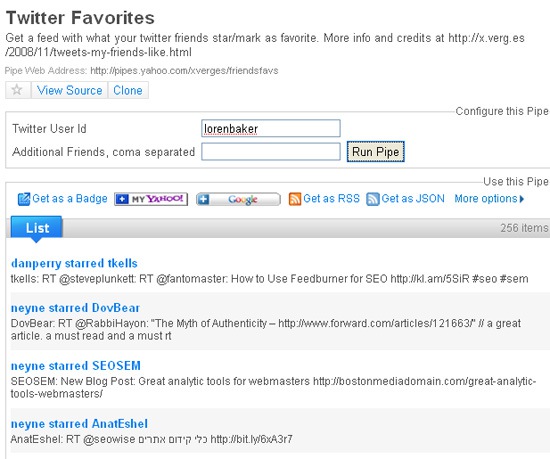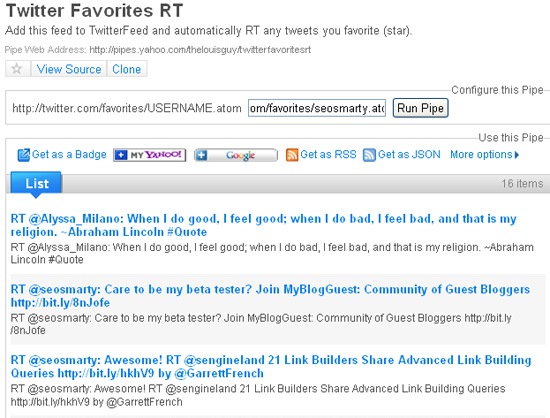fotografía señoras viñedos camino del cid franquicia ahorros
"Search Engine Journal" - 6 new articles
- Facebook to Change "Become a Fan" Button to "Like" on Fan Pages
- 5 Handy SEO Hacks for Google Analytics
- Pitching Link Requests – One Size Doesn't Fit All
- 2 More Alternative Uses of Twitter Favorites You've Never Known About
- Link Bait Auto-Generated
- 3 Tools That Make Google's Site Search Easier to Run
- More Recent Articles
- Search Search Engine Journal
Facebook to Change "Become a Fan" Button to "Like" on Fan Pages
Facebook will soon be changing the "Become a Fan" button that you see on Fan Pages to the more universal "Like" button. According to the site Clickz, Facebook has started sending confidential email to ad agencies informing them that the "Become a Fan" button which functions as a subscription/membership button to fan pages will be changed to "Like" button within the next few weeks.
And what could be the reason for the upcoming change? Unfortunately, no specific details were divulged yet from the email sent to ad agencies. Facebook just wanted to give them advance notices as this might affect their advertising campaigns or Facebook strategy. This is particularly so since Facebook is recommending that ad agencies start using the phrase – "Find us on Facebook" or "Like us on Facebook" instead of the current "Became a fan."
In addition, the email also explained that the new "Like" button will be different from the current "Like" button that Facebook users click whenever they like particular updates of their friends.
Facebook believes that by changing the "Become a Fan" button to "Like" will increase engagement between consumers and brands as it offers a simple, consistent way for Facebook users to connect with the things they are interested in. Facebook did some research and found out the users are more likely to "Like" something instead of becoming a fan.
Check out the SEO Tools guide at Search Engine Journal.
Facebook to Change "Become a Fan" Button to "Like" on Fan Pages
5 Handy SEO Hacks for Google Analytics
It's fair to say that most of us are running Google Analytics on at least a few of the sites we deal with.
Market share for Google's traffic tracking platform was estimated last year around 75-80% in a few separate studies – here's one from Ghostery.
Let's not get into the whole "Google knows too much" thing. The truth is, the platform is a pretty solid and user-friendly. (Even if it is the lure of an evil empire.)
But from an SEO standpoint Google ANalytics definitely leaves some things to be desired.
Luckily there are plenty of clever SEOs out there who take on complicated and difficult projects that make our lives easier.
Here are five such supergeek gifts that hack Google Analytics into a killer SEO tool:
1. Ranking Tracking with Google Analytics
This guest post on Yoast's blog from Andrй Scholten walks you through how to use custom filters to pull the referring page from Google – which tells you on which page the site is ranking in search results.
Ideally we'd see which position, but until Google rolls out AJAX search results (or some other version) we'll settle for this.
Note: it's a good idea to create a new, duplicate profile for whatever site you're going to try this on. Filters work on data before it's collected. That means if you do something wrong and end up filtering the wrong data (or all data) you can't get it back.
2. Better Google Analytics Firefox Extension
This nifty Firefox extension from VKI Studios uses Greasemonkey userscripts to enhance your interaction with Google Analytics.
First, it allows you enter Google Analytics quicker/easier – for example, it kills that annoying 2nd step of clicking the big blue "Access Analytics" button by clicking it automatically.
Second, and more importantly, this extension gives you better tools and data inside the reports, such as:
- Allows you to perform Google Insights research on keywords in your reports
- Adds Social Media Metrics and Yahoo inbound link metrics to reports
- Ability to export data to Google Docs
- Converts percent values to absolute values in tables
- Allows you to jump between profiles while carrying over your current report and settings
That's not all it does, but you'll have to install it yourself to give it a try – it's a good one.
3. Google Analytics Report Enhancer
This Greasemonkey script from Jeremy over at ROI Revolution adds a ton of additional data to your reports – including the raw number of conversions (instead of just a percentage) as well as conversion revenue.
If you've worked with GA for eCommerce sites you know that having this data in separate reports can drive you nuts. This script pulls them all in.
Jeremy also included a modified segment drop-down menu, which adds the ability to segment individual page/content traffic by both source and medium (which GA doesn't do out of the box).
4. Initial Referrer Tracking for Google Analytics
Google Analytics, by default, will only track the last referring source/medium that led to a conversion.
This means the last in line gets the credit.
The problem is that users often visit a site more than once before they decide to purchase/sign-up/whatever (especially if what's on offer is a bigger commitment with a longer sales cycle). Sometimes the conversion credit goes to a branded search term instead of the non-branded term that originally made the referral.
This script, original written by Brian Clifton of Advanced-Web-Metrics.com, was modified by the folks at FreshClicks.net to correct a few small errors. It stores the initial referrer using the User Defined variable for Google Analytics – so you get a more complete story when visitors visit more than once before converting.
5. Tracking Universal Search Traffic with Google Analytics
Martijn Beijk of SearchCowboys.com was annoyed that Google Analytics didn't show you traffic that came through the blended universal search results. So he set out to dissect the source code of the universal SERPs.
The result is this how-to guide that walks you through setting up custom filters that pull this data into your GA reports. With this can you segment users who click on images/videos/local/etc from users who click the regular results – which means you can measure how these users behave (and convert).
As #1 above, it's a good idea to create a new, duplicate site profile before you start tinkering with filters if you aren't experienced.
Got any SEO hacks for Google Analytics that I don't know about? Give 'em up!
Check out the SEO Tools guide at Search Engine Journal.
5 Handy SEO Hacks for Google Analytics

Pitching Link Requests – One Size Doesn't Fit All
Imagine that you are a salesperson for a shoe store. There are three potential customers in the store – an athletic male, a professionally dressed female, and a rugged outdoorsman.
Approach #1: You tell all three potential customers that you have 100% authentic Australian made Ugg Boots at discounted prices.
Approach #2: You tell the athletic male that Nike running shoes on sale. You tell the professional female that designer pumps are on special this week only. You tell the outdoorsman that hiking boots are on clearance.
Which of the following approaches will get the most sales? And what does this have to do with link requests?
You have seen them. The cookie cutter link requests that are probably sent out to hundreds of people with the same anchor text and description. More often than not, the links themselves have nothing to do with anything on the website. Since they are sent out in mass, they probably do get some results. But are the results high quality and relevant?
The Link Request Sales Pitch
Consider link requests like sales pitches, with the webmaster as the potential customer. How can you customize your pitch to fit each customer?
Analyze the Website
First, take a good look around the website. Is it personal or professional? Is it directly or indirectly related to the link I want to have added to their site? The ultimate goal is determining how the link request will benefit their site and their visitors.
Find a Contact Name
Good salespeople like to address their potential customers by name. So look for the name of the website owner (if possible) or find a directory that lists the name of the person who runs the website. This way, instead of "Dear Webmaster" you can send something more personalized and direct.
Preferred Contact Method
Each website has a preferred method of contact, whether it is by email to a specific department or through a contact form. If the page you would like to have your link added to has contact information for someone who maintains that page or directs you to their contact form, that is the avenue through which you should request the link.
Study the Link Format
When crafting the request, look at how links are formatted on the page your link would be placed upon. Are they using URL's, company names, or anchor text? Do they have a short or detailed description, or additional information such as address, phone number, etc.? However they link to other sites is how your link details should be formatted. If the link details you send do not fit the mold, and the webmaster has to contact you for additional details, then chances are they are not going to respond at all.
Prove the Link's Value
The thing that closes the sale is making your product valuable, and this can definitely be said about links. The link you want to place has to be a valuable to the website owner and their visitors. So if you have the option to add a description to your link, make sure the description is something that is enticing to the website's visitors. Otherwise, be sure to emphasize how the link you are submitting is valuable to the website's visitors in your link request.
Check for Broken Links
Now, for that little something extra. If there is one thing webmaster's despise, it's broken links. There is a Firefox plugin called Check Page Links, and all you have to do is right click on a page and run the plugin to highlight broken links. Typically, there is at least one on the page to which you want to be added. Letting the webmaster or site owner know that one of their resources is no longer available means they are more likely to take the time to edit the page. While they are there, they might as well add on your valuable link, especially if it's a good replacement to one they just lost.
Is it Worth It?
Does this sound like a lot of extra work? Maybe. But you have to look at it this way. As a link builder, you could spend a lot of time seeking out a large quantity of sites, send a pre-formatted template, and receive positive responses from only a small percentage of those sites. Or, you could take a little extra time with each request you send out to higher quality sites, and receive a larger percentage of positive responses from a smaller amount of requests. Also, if you personalize the request, it will be less likely to be reported as spam than the generic sounding requests.
Check out the SEO Tools guide at Search Engine Journal.
Pitching Link Requests – One Size Doesn't Fit All
2 More Alternative Uses of Twitter Favorites You've Never Known About
It is always fun to discover new and new possibilities of well-known tools. I already shared one tip on how Twitter favorites may help you better understand what your friends like and build closer relations with them.
This week I am sharing two more interesting uses of Twitter favorites:
Subscribe to Your (or Anyone's) Friends' Favorites
Would you like to keep track of what your friends are adding to favorites on Twitter? This way you can:
- Follow your friends more effectively (especially if you have quite a few of them);
- Monitor useful content shared on Twitter (especially if you were picky when adding to friends and thus mostly follow people interested in the same topic as you).
To aggregate all your friends' favorites into one combined RSS feed, you can use Yahoo! Pipes for that or you can find already created pipes and grab the RSS feed.
Here are a couple of them (neither of them requires authentication):
- Twitter Favorites from your Friends (provide your Twitter username, generate the feed and subscribe to it using your preferred feed reader).
- Twitter Favorites is another alternative that only works for 36 contacts that are shown in a user's page.
Turn Your Favorites into the RTs:
Warning: this tip may also be used for some spammy tactics, so please don't.
You can use your Twitter favorites (in combination with Twitterfeed) to create a Twitter bot that will Retweet some topical Twitter updates. This may work the following way:
- Create a Twitter account related to some topic you are interested in (better for some quite specific and rare one);
- Favorite all Tweets related to that topic you come across;
- (Optionally but fun) Get your friends join your initiative and feed their favorites as well.
- Feed your (and all the participants') favorites and use Twitterfeed to tweet them;
- The bot will be retweeting your (and all the participants') favorites.
Here are two pipes that will make that task easier:
- Twitter Favorites into Retweets (clone the pipe and change the source RSS to your Twitter favorites one):
- Twitter Favorites RT (changes USERNAME to your Twitter username and run the pipe):
Check out the SEO Tools guide at Search Engine Journal.
2 More Alternative Uses of Twitter Favorites You've Never Known About
Link Bait Auto-Generated
Warning: this post is intended to be sarcastic. It shows how some fun link-baiting article (you may see on the front page of many popular social sharing sites) can be generated with help of simple web-based free tools.
By this sarcasm, I don't mean to say that I am not guilty myself, so who be the judge? :)
1. Need some ideas?
Start with a catchy title. You will be able to think about content from there.
How? There are many ways, the easiest of which is to take advantage of this Link Bait Generator.
For any given keyword it will generate you dozens of cool titles – I typed "Apple" just for fun and it actually made me want to write of those articles! :)
2. Now even more ideas
Ok, now you have a title. You are half-way to the success. To get even more inspired, try this slogan generator.
Try this slogan generator for more cool ideas:
3. Put your ideas on the graphic
Need some cool-looking link-baity customized image to reinforce the effect?
Make it look like some breaking news: The Newspaper Clipping Image Generator
- Name the newspaper;
- Provide the date;
- Specify the article heading;
- Copy paste some text:
Now even more fun: make Bart Simpson chalk this on the Board:
From there on, you just need some content which won't really be a problem :)
Check out the SEO Tools guide at Search Engine Journal.
Link Bait Auto-Generated
3 Tools That Make Google's Site Search Easier to Run
Google's SEARCH operator (which restricts the search to any domain, top level domain or subdirectory) is by far the most important and most frequently used (by me). I use it For example, I use it hundreds of times when writing each post to see which other related pages of the site thee are I can link to. Besides:
- It allows me to never care to look for any site built-in search option;
- It makes it possible to find most relevant pages from any site – which comes in handy both in link building (to find the best page for your backlink) and competitor's research (to find your competitors recent or most powerful pages);
- It allows for multiple on-site diagnostics opportunities, etc, etc.
This post looks at three handy tools that make Google's SITE: operator easier and faster to access:
1. Advanced Dork:
Access Google's SITE: search for any highlighted term from the right-click context menus:
2. Search Site
This addon is connected to the FireFox search plugins, that is it will use the search engine that is now active in your searchbar, so make sure it is Google:
Search Site allows two ways to quickly access Google's SITE: search: first, like Advanced Dork, it has a handy right-click context option for the highlighted phrase:
Besides, you can use the new green "Search Site" icon that you will notice in your browser searchbar:
3. Google site search
(runs on Greasemonkey)
Use the keyboard shortcut CTRL+ 9 ( Mac) and Shift+ALT+9 (Windows) to see the search form. From there, choose the site directory level you want to restrict the search to (for the current site):
You can also create your own search plugin to search within any site: here's a quick guide on how you can do that.
Check out the SEO Tools guide at Search Engine Journal.
3 Tools That Make Google's Site Search Easier to Run
More Recent Articles


Your requested content delivery powered by FeedBlitz, LLC, 9 Thoreau Way, Sudbury, MA 01776, USA. +1.978.776.9498
martes, 30 de marzo de 2010
Suscribirse a:
Enviar comentarios (Atom)
Seguidores
Archivo del blog
-
▼
2010
(127)
- ► septiembre (7)
-
▼
marzo
(36)
- <!-- AOL_MESSAGE --><!-- Your FeedBlitz Updates ...
- <!-- AOL_MESSAGE --><!-- Your FeedBlitz Updates ...
- <!-- AOL_MESSAGE --><!-- Your FeedBlitz Updates ...
- <!-- Centro de Información WPERU --><!-- ...
- <!-- AOL_MESSAGE --><!-- Your FeedBlitz Updates ...
- <!-- AOL_MESSAGE --><!-- Your FeedBlitz Updates ...
- <!-- AOL_MESSAGE --><!-- Your FeedBlitz Updates ...
- Del iPhone al iPad
- <!-- AOL_MESSAGE --><!-- Your FeedBlitz Updates ...
- <!-- AOL_MESSAGE --><!-- Your FeedBlitz Updates ...
- Best-ever Freeware"
- <!-- AOL_MESSAGE --><!-- Your FeedBlitz Updates ...
- <!-- AOL_MESSAGE --><!-- Your FeedBlitz Updates ...
- <!-- AOL_MESSAGE --><!-- Your FeedBlitz Updates ...
- <!-- Carrero» , Carrero. David Carrero y Jaime C...
- <!-- AOL_MESSAGE --><!-- Your FeedBlitz Updates ...
- <!-- AOL_MESSAGE --><!-- Your FeedBlitz Updates ...
- - 10 new articles
- <!-- AOL_MESSAGE --><!-- Your FeedBlitz Updates ...
- <!-- Carrero» , Carrero. David Carrero y Jaime C...
- <!-- Blog de informatica --><!-- ...
- <!-- AOL_MESSAGE --><!-- Your FeedBlitz Updates ...
- <!-- AOL_MESSAGE --><!-- Your FeedBlitz Updates ...
- <!-- AOL_MESSAGE --><!-- Your FeedBlitz Updates ...
- A Time and Season for Search: How Data Mining Can...
- <!-- Carrero» , Carrero. David Carrero y Jaime C...
- <!-- Carrero» , Carrero. David Carrero y Jaime C...
- <!-- Carrero» , Carrero. David Carrero y Jaime C...
- Watch the 2010 Oscars : Academy Awards Online
- Google Buys Online Collaboration Operator DocVerse
- <!-- AOL_MESSAGE --><!-- Your FeedBlitz Updates ...
- <!-- Carrero» , Carrero. David Carrero y Jaime C...
- <!-- Carrero» , Carrero. David Carrero y Jaime C...
- <!-- AOL_MESSAGE --><!-- Your FeedBlitz Updates ...
- Twitter Newsletter 2010 - Edition #1
- <!-- AOL_MESSAGE --><!-- Your FeedBlitz Updates ...












No hay comentarios:
Publicar un comentario